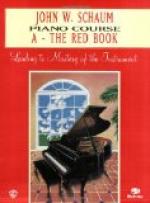FOUNDATIONAL EXERCISES
“We begin with table work. I use about ten different exercises which embody, as it were, in a nutshell, the principles of piano playing. The hand is first formed in an arched position, with curved fingers, and solidified. The thumb has to be taught to move properly, for many people have never learned to control it at all.
“With the hand in firm, solid position, and the arm hanging freely from the shoulder, I begin to use combined arm and wrist movements, aiming to get the weight of the arm as well as its energy at the complete disposal of the finger tip. Each finger in turn is held firmly in a curved position and played with a rotary movement of arm and wrist. When this can be done we next learn hand action at the wrist from which results the staccato touch. In this form of hand staccato there is an element of percussion, as you see, but this element gives directness and precision to the staccato touch, which in my opinion are necessary. After this we come to finger action itself. This principle is taken up thoroughly, first with one finger, then with two, three, four, and five—in all possible combinations. In this way we come down from the large free-arm movements to the smaller finger movements; from the ’general to the particular,’ instead of working from the smaller to the larger. I find it most necessary to establish relaxation first, then strengthen and build up the hand, before finger action to any extent is used. When these foundational points have been acquired, the trill, scales, arpeggios, chords, octaves and double notes follow in due course. At the same time the rhythmic sense is developed, all varieties of touch and dynamics introduced, and harmonic and structural analysis dwelt upon.
USE OF STUDIES
“Above the third or fourth grade I make frequent use of studies, selecting them from various books. Duvernoy, Op. 120; Berens, Op. 61; Czerny, Op. 740 I find far more interesting than the threadbare 299. Heller is indispensable, so melodious and musical. Arthur Foote’s studies, Op. 27, are very useful; also MacDowell’s, Op. 39 and 46. Sometimes I use a few of Cramer’s and the Clementi ‘Gradus,’ though these seem rather old-fashioned now.
“For more advanced pupils I find Harberbier, Op. 53 especially applicable; there is beautiful work in them. Kessler, Op. 20, and the Moszkowski studies, Op. 72, have splendid material for the advanced player, and prepare for Henselt, Rubinstein, Chopin and Liszt etudes. I find that studies are valuable for application of technical principles, for reacting purposes, and for the cultivation of all the refinements of playing. Some teachers believe in applying the technic directly to pieces, and use almost no studies; but I think a study is often more valuable than a piece, because a definite technical principle is treated in every kind of way. Though I do not require studies to be memorized, they must be played with all the finish of a piece, if the pupil is to derive the maximum of benefit from them.




